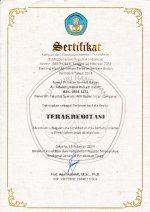Islam and the Provisions of War
Abstract
This article compares the provisions of war in Islam with the provisions contained in International Humanitarian Law (The four Geneva Conventions of 1949 and their Additional Protocols). The aim is not to judge Islamic according to or vice versa, but rather, to discover similarities and differences between the two regulations in governing the conduct of war. The study uses a comparative approach, exploring the Islamic values of ethics and rules of conduct of war and then comparing them with similar provisions of international humanitarian law. This article also analyzes the possibility of synthesizing the two legal system. Having reviewed the topic thoroughly, this study concludes that, in principle, there is no difference between Islamic law and international humanitarian law in regulating procedures and ethics of warfare. Both of the legal system are equallyconcern to regulate the behaviour of warriors by limiting the use of force and minimizing the impact of the battles to civilians
Keywords
Full Text:
PDFReferences
Ahamat, Haniff, and Mohd Hisham Mohd Kamal. ‘Modern Application of Siyar (Islamic Law of Nations): Some Preliminary Observations’, Arab Law Quarterly, 25 (2011), 423.
Bayhaqî, A. al-. Sunan al-Bayhaqî al-Kubrâ. Makkah: Maktabat Dâr al-Bâz, 1994.
Bennoune, Karima. ‘al-Salamu Alaykum-Humanitarian Law in Islamic Jurisprudence’, Mich. J. Int’l L., 15 (1993), 605.
Boisard, Marcel A. ‘On the Probable Influence of Islam on Western Public and International Law’, International Journal of Middle East Studies 11 (1980), 429–50
Buchan, Russell. ‘The Rule of Surrender in International Humanitarian Law’, Israel Law Review, 51 (2018), 3–27.
Collier, Robert. ‘Nuclear Weapons Unholy, Iran Says’, San Francisco Chronicle, 2003.
El Moudden, Abderrahmane. ‘The Idea of the Caliphate between Moroccans and Ottomans: Political and Symbolic Stakes in the 16th and 17th Century-Maghrib’, Studia Islamica, (1995), 103–12.
El-Dakkak, M. Shokry. State’s Crimes against Humanity: Genocide, Deportation, and Torture from the Perspectives of International and Islamic Laws. Ttp.: AS Noordeen, 2000.
Engeland, Anisseh Van. ‘The Differences and Similarities between International Humanitarian Law and Islamic Humanitarian Law: Is There Ground for Reconciliation?’, Journal of Islamic Law and Culture, 10 (2008), 81–99
Ereksoussi, M. Kheir. Le Coran et Les Conventions Humanitaires. Ttp.: Comité international de la Croix-Rouge, 1960.
Farabi, Abu Nasr al-. Kitab Fi Tashil al-Sa’adah (On the Achievement of Happiness) (Research by Jafar al-Yassin). Bayrut: Dâr al-Andolus, 1982.
Gaggioli, Gloria. ‘International Humanitarian Law: The Legal Framework for Humanitarian Forensic Action’, Forensic Science International, 282 (2018), 184–194.
Ghazi, Mahmood Ahmad. ‘The Law of War and Concept of Jihad in Islam’, Policy Perspectives, 5 (2008), 69–86.
Haleem, MA Abdel, The Qur’an. Ttp.: OUP Oxford, 2005.
Haykal, Muhammad Khayr. ‘al-Jihad Wa al-Qital Fi al-Siyasa al-Shara ‘Iyya’, English:‘Jihad and Fighting According to the Shar ‘Ia Policy’. Bayrût: Dâr al-Barayiq, 2 (1993), 995–997.
Hogg, John, Doug Lea, Alan Wills, Dennis deChampeaux, and Richard Holt. “The Geneva Convention on the Treatment of Object Aliasing.” ACM SIGPLAN OOPS Messenger 3, no. 2 (1992): 11-16.
Khairuddin, Abdul Rashid, Kobayashi Kiyoshi, and Hasan Sharina Farihah. Concept and Application of Shariah for the Construction Industry: Shariah Compliance in Construction Contracts, Project Finance and Risk Management. World Scientific, 2018.
Lewis, Bernard. The Political Language of Islam. Ttp.: University of Chicago Press, 2018.
Maraghi, Syeikh Ahmad Mustafa. Tafsir al-Maraghi. Ttp.: Dar al-Fikr, 2001.
Nawawî, Shâfi’î Abû Zakaria al-, and Yahya bin Sharaf bin Marî, ‘Sharh al-Nawawî Ala Muslim’, Kairo: al-Matba’ah al-Mishriyah, 1929.
Okon, Etim E. ‘Islam, ‘War and International Humanitarian Law’, European Scientific Journal, ESJ, 10 (2014)
Pictet, Jean S., and Jean De Preux. “Geneva Convention Relative to the Treatment of Prisoners of War.” (1960).
_____. ed. Geneva Convention Relative to the Protection of Civilian Persons in Time of War. International Committee of the Red Cross, 1958.
_____. “Commentary Geneva Convention I.” International Committee of the Red Cross, Geneva Google Scholar (1952).
J. A. C. Gutteridge, “The 1958 Geneva Convention on the Continental Shelf.” Brit. Yb Int’l L. 35 (1959), 102.
Qaradhâwî, Yusuf al-. Fiqh al-Jihâd: Dirâsah Muqâranah Li Ahkâmih Wa Falsafatih Fî al-Qur’ân Wa al- Sunnah. Cairo: Maktabah Wahbah, n.d.
Qudamah, Ibn. al-Mughni Fi Fiqh al-Imam Ahmad Ibn Hanbal alShaybani. Bayrut: Dar al-Fikr, n.d.
Renard, John, ‘Ahmed al-Dawoody, The Islamic Law of War: Justifications and Regulations’, Political Theology, 12 (2011), 930–32
Roberts, Adam. ‘Documents on the Laws of War’, International Review of Red Cross, 82 (2000), 1095.
Salami, Esmaeil. Islamic Views on Human Rights: Viewpoints of Iranian Scholars. UK: Alhoda UK, 2003.
Sarakhsi, Abi Bakr al-. ‘Sharh al-Siyar al-Kabir’, Edited by S. al Munajid. Multivolume. Cairo: Ma’had al-Makhtutat, 1971.
Scheuer, Michael. ‘Coalition Warfare: How al-Qaeda Uses the World
Islamic Front against Crusaders and Jews, Part I’, Terrorism Focus, 2 (2005), 31.
Sultan, Hamed. ‘La Conception Islamique’, Les Dimensions Internationales Du Droit Humanitaire, 1986.
Wiktorowicz, Quintan, and John Kaltner. ‘Killing in the Name of Islam: al-Qaeda’s Justification for September 11’, Middle East Policy, 10 (2003), 76–92.
Young, Richard. “The Geneva Convention on the Continental Shelf: A First Impression.” American Journal of International Law 52, no. 4 (1958), 733-738.
Zahid, Anowar, and Rohimi Shapiee. ‘Customs as a Source of Siyar and International Law: A Comparison of the Qualifying Criteria’, Int’l J. Civ. Soc’y L., 8 (2010), 36.
Zahrah, Muhammad Abû. al-Jarîmah Wa al-‘Uqûbah Fî al-Fiqh al Islâmî: al-‘Uqûbah. Ttp.: Dâr al-Fikr al-‘Arabî, 1966.
Zaman, Muhammad Qasim. ‘The Caliphs, the ‘Ulamâ’, and the Law: Defining the Role and Function of the Caliph in the Early ‘Abbâsid Period’, Islamic Law and Society, 4 (1997), 1–36.
DOI: http://dx.doi.org/10.24042/adalah.v15i2.3549
Refbacks
- There are currently no refbacks.
Copyright (c) 2019 AL-'ADALAH
Al-'Adalah is licensed under a Creative Commons Attribution-ShareAlike 4.0 International License.



.png)
_(1).png)
_(1).png)

.png)
